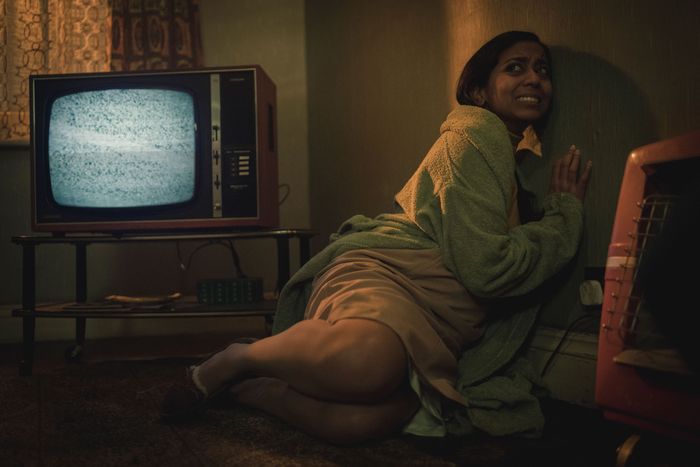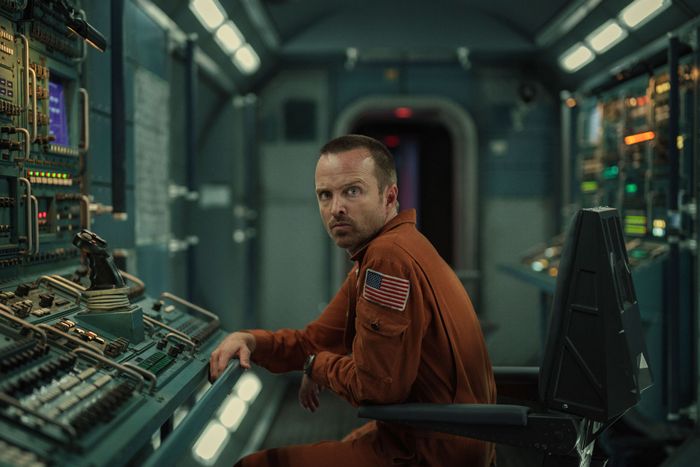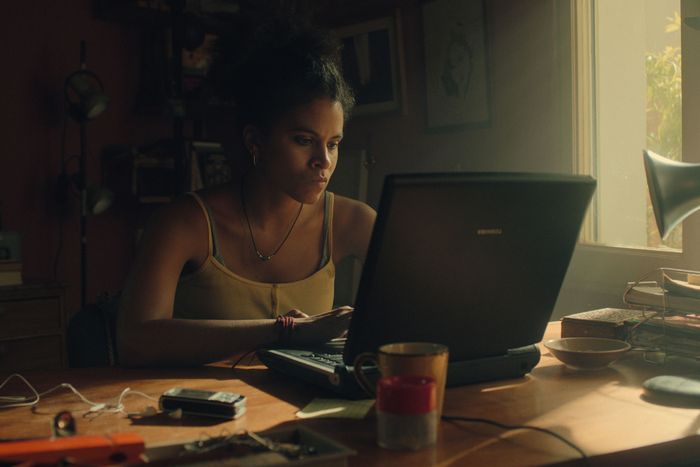
Note: Spoilers about the sixth season of Black Mirror are sprinkled throughout this piece.
Black Mirror has been telling high-tech horror stories since the Obama administration — we’re talking first term — and stoking fears about AI before ChatGPT was even a gleam in the eye of global capitalism. That may be one reason why creator Charlie Brooker thought it was time to shake up his approach a bit in season six, the first batch of Black Mirror episodes to arrive in a post-pandemic world, by opting to gaze backward.
In a change from the usual Black Mirror format, three of the five new installments that dropped this week on Netflix qualify as genuine period pieces. “Beyond the Sea,” about the relationship between two astronauts who work in space while also existing as replicants on Earth, takes place in an alternate version of 1969; “Mazey Day,” a mini monster movie about L.A. paparazzi, is set in 2006; and “Demon 79,” which focuses on a British Indian shoe saleswoman who believes she must commit several murders to avert the apocalypse, unfolds in the late 1970s. And while the season’s first two episodes are present-day stories, both zero in on pop culture’s fixation on the past. It’s as if Brooker is reminding us, in our own heightened moment of technological anxiety, that the future has seemed scary in every era because innovation has always held the potential to rob people of their humanity.
That potential is realized in the two present-day entries that kick off the season, “Joan Is Awful” and “Loch Henry,” which I highly recommend watching as a double feature because their themes are so symbiotic. The former follows an average, flawed woman named Joan (Annie Murphy, unhinged in the best way) who realizes that her life, with all its morally compromised choices, is being made into a series called Joan Is Awful that rolls out practically in real time on Netflix. Okay, technically the streamer that carries the series is called Streamberry, but it’s obviously Netflix, right down to its “tudum” sound and an algorithm that knows way too much about its users. Basically, “Joan Is Awful” is a “Fuck you” to Netflix appearing on Netflix while many of Hollywood’s writers are currently holding picket signs that more or less say, “Fuck you, Netflix.” Because of the issues currently being raised by the Writers and Screen Actors Guilds, it’s an episode of TV that feels like it could have been written two minutes ago, about a TV show that depicts what happened to its protagonist two minutes ago.
While the episode contends most obviously with concerns about AI, privacy, and tech overreach, it also functions as commentary on how quickly studios turn true stories into scripted television. In an interview with Esquire, Brooker says he solidified the concept for the episode after watching The Dropout, which he describes as the equivalent of “dramatizing things that happened ten minutes ago.” In that sense, “Joan Is Awful” can be seen as an indictment of the entertainment industry’s rush to put recent history in new contexts before enough time has passed to put it in any real context at all.
That idea pops up again in “Loch Henry,” a true-crime story about the exploitative nature of the genre. In a bit of foreshadowing, “Loch Henry” is seen as a viewing option on Joan’s Streamberry app in “Joan Is Awful,” but here it’s the analog media of the past, rather than our streaming present, that pushes the narrative forward. When Davis (Samuel Blenkin), a budding documentarian, and Pia (Myha’la Herrold), his girlfriend and creative partner, decide to make a documentary about murders committed 26 years ago in Davis’s Scottish hometown, they rely on what qualified as tech back then: VHS tapes. Pia eventually discovers some chilling footage that reveals the identities of the actual killers buried on the videotapes of BBC detective series Bergerac that line the shelves in Davis’s mother’s family room.
Davis is able to use that footage to make and sell what ultimately becomes a BAFTA-winning true-crime doc for, yes, Streamberry. (In another of Black Mirror’s many self-referential Easter eggs, the other nominees in the same BAFTA category, Suffer the Children: The Tipley Pedophile Ring and Euthanasia: Inside Project Junipero, reference other Black Mirror episodes.) But despite the success of the doc — which of course is already being developed into a scripted series — Davis winds up bereft at the end of the episode: alone, staring into the blank eyes of his BAFTA trophy, unsure who he even is anymore. Dredging up the past, “Loch Henry” tells us, comes at a cost.
But dredging up the past is precisely what happens in the next three episodes, which revisit previous eras to explore one of Black Mirror’s pet themes: the way technology and media can isolate us from each other. “Beyond the Sea,” a relationship study catalyzed by fictional tech in the vein of season two’s “Be Right Back,” introduces two space-station technicians who spend their free time on Earth as replicants living with their wives and kids. By setting the episode in the heart of America’s Space Race era, Brooker and director John Crowley tap into the spirit of a time when there was public excitement about the future, reflected in scenes where regular citizens treat the replicants, Cliff (Aaron Paul) and David (Josh Hartnett), with an awe and reverence normally reserved for movie stars — or men who have walked on the moon.
But it wouldn’t be Black Mirror if technology didn’t eventually lead to destruction. After David’s replicant and his family are murdered, stranding the actual David permanently in outer space, Cliff starts letting his partner use his replicant to visit Earth and ease the burden of his grief. Within the shell of Cliff’s physical replicant, David begins to develop feelings for Cliff’s wife, Lana (Kate Mara), a scenario that escalates until, eventually, Cliff and David both lose everything and become confined to their floating ship, forever.
“Beyond the Sea” is the rare Black Mirror episode whose message resonates in the present, yet theoretically could have worked as an original episode of The Twilight Zone, if broadcast television in the 1960s had accommodated profanity and sex scenes. The experiences it depicts, and its message about how innovations meant to foster connection can just as easily erode it, would have been as relatable then as they are now.
“Mazey Day,” on the other hand, grounds itself so firmly in 2006 that it’s impossible to separate it from that very specific moment. Its opening sequence even unfolds on the day that Suri Cruise is born, emphasizing that this story is set during the dawn of the TMZ era, a time when its protagonist, a freelance celebrity photographer played by Zazie Beetz, has the opportunity to make tons of cash if she nabs the best candid shot of somebody famous.
As in “Loch Henry,” this episode does not center on any futuristic gadgets or devices. Instead it interrogates the assumptions we make about famous people based on what we see on our screens and down our camera lenses. Beetz’s Bo thinks she and some of her photographer colleagues are hunting down the well-known actress Mazey Day (Clara Rugaard), who has recently had a public meltdown. But in the most surprising twist in this season of Black Mirror, that predator-prey relationship between paparazzi and star is flipped on its head, proving a point similar to the one made in the preceding three episodes: You can’t really understand another person’s pain when you’re watching it from a distance.
Brooker originally envisioned the fifth and final episode, “Demon 79,” as part of an all-retro spinoff series he planned to call Red Mirror, and it indeed stands out as the least Black Mirror–y of the current episodes, but it still reckons with the themes of dehumanization that shape the rest of season six. Its main character, Nida (Anjana Vasan of We Are Lady Parts), finds a talisman that ushers a demon (Paapa Essiedu) into her life who insists that she must commit several murders in order to avoid mass extinction on Earth, a premise that may remind viewers of M. Night Shyamalan’s recent adaptation of Knock at the Cabin. The source of futuristic terror here is not AI or a streaming service. For the white people who live in Tipley, the town where Nida lives and works, it’s the racist fear that they’ll soon be outnumbered by people of color like her. And for people more broadly, it’s the specter of nuclear war that lurks in every news report about the prickly relations between the U.K. and Russia.
Even though the mode of storytelling differs from the Black Mirror norm, “Demon 79,” co-written by Brooker and Bisha K. Ali (Ms. Marvel), boasts a thoroughly committed and believable performance from Vasan. Nevertheless, it still feels a bit like it wandered away from a different anthology series and accidentally wound up in a season of Black Mirror. But that doesn’t fully detract from the overall high quality of these episodes, which suggest that there’s still life in Black Mirror a decade into its run because Brooker is actively mixing new ingredients into the anthology’s established formulas.
By showcasing so many period pieces in season six, Black Mirror offers a twist — of course there’s a twist — on the usual ominous warnings about the near-future. This time, we’re being asked to consider our history and the way human beings have always misused and misunderstood the tools we’re given, be they an ancient talisman or new tech. The only way to stop that cycle is to learn from the mistakes of our past, while we still have time.






